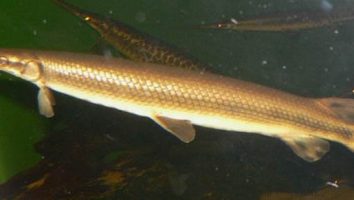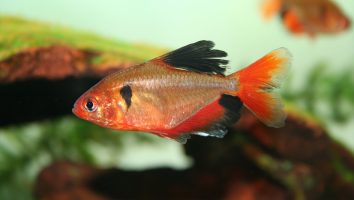The Neon Tetra is one of the world’s most popular freshwater fish for beginners, and it’s easy to see why.
These little guys are absolutely gorgeous, and they’re very easy to care for.
But even though they’re easy to care for, there are still a few things you need to know to keep them healthy and happy.
In this guide, we’ll teach you everything you need to know about Neon Tetra care. Tank size, diet, lifespan, tank mates, you name it.
Table of contents
Species overview
Neon tetras (Paracheirodon innesi) are one of the most popular freshwater fish in the world and are native to the Orinoco River basin in South America.
They are a small fish that only grow to be about an inch long, which makes them a popular choice for nano aquariums.
In the wild, they eat a diet of small insects, crustaceans, and other invertebrates. In the aquarium, they can be fed a diet of small live or frozen foods.
Neon tetras are a peaceful fish that do well in community tanks. They are schooling fish, so it is recommended to keep them in groups of at least six.
The Neon tetra is most famous for its bright blue and red stripes. This coloration is what makes them one of the most popular freshwater fish in the world.
Appearance

The Neon Tetra is one of the most popular freshwater fish in the world and it’s easy to see why. These little fish are very colorful and eye-catching.
As you can probably guess from their name, the Neon Tetra is a bright neon blue color. This color is accented by a bright red stripe that runs from their nose all the way to the base of their tail.
This red stripe is actually quite thin, but it’s very noticeable against their blue body.
Neon Tetras have a very thin and streamlined body shape. This helps them to be very speedy swimmers.
Their fins are all fairly standard for a small freshwater fish. They have a moderately sized dorsal fin that starts about two-thirds of the way back on their body.
Their anal and pectoral fins are both thin and small. The caudal fin is forked and quite tall in comparison to the rest of their body.
Each of their fins is translucent with a slight yellow tinge.
Lifespan
Neon tetras are a little different from most other fish in that they have a very short lifespan in the wild. In the wild, they only live for about two years.
This is likely due to the fact that they’re very easy prey for predators. However, in captivity, they can live for much longer.
The average lifespan of a neon tetra in captivity is between five and eight years. This is a significant increase from their lifespan in the wild.
There are a number of factors that contribute to this increase. For starters, they’re not as easy prey in captivity. They also tend to be less stressed in captivity and have access to better food.
Size
Neon tetras are relatively small fish. In the wild, they only grow to be about 1.5 inches long. However, in captivity, they can reach up to 2 inches in length.
Tank
Tank Size
The recommended minimum tank size for a neon tetra is 10 gallons. This is assuming you’re keeping them in a school of at least 5 or 6 fish (which you should).
We personally recommend a slightly larger tank if you can accommodate it. Every extra space will make a big difference and allow you to keep a larger school or more tank mates if you’re interested in a community tank.
Water Parameters
Neon tetras are one of the most popular freshwater fish in the aquarium trade. They’re beautiful, peaceful, and relatively easy to care for.
One of the reasons they’re so popular is that they’re easy to find. Neon tetras are widely bred in captivity, which means you can find them just about anywhere. That includes your local fish store, big box pet retailer, and online.
No matter where you buy them, though, it’s important to remember that these are tropical fish. That means they need warm water to thrive.
Here are a few basic water parameters to help create a healthy environment for your neon tetras.
- Water temperature: 70 to 80 degrees Fahrenheit
- pH levels: 6.0 to 7.6
- Water hardness: 2 to 12 dGH
- Alkalinity Levels: 4-8 dKH
What To Put In Their Tank
Neon tetras are a pretty popular freshwater species. They’re small, brightly colored, and relatively easy to care for.
One of the benefits of their small size is that they don’t require a ton of space. This gives you a little more leeway when it comes to decorating their tank.
We recommend going with a classic gravel substrate. This is a tried and true option that works well in most freshwater tanks.
As for decorations, it’s really up to you. Neon tetras are pretty flexible when it comes to this sort of thing.
We’ve seen tanks with all sorts of plants, rocks, and driftwood. As long as there’s enough space for them to swim around and some hiding spots they’ll be happy.
One important thing to keep in mind is that these fish like to school. This means you should keep them in groups of at least 6.
This will help reduce their stress levels and make them feel more comfortable in their environment. It’s also just more fun to watch a school of fish swim around!
Common Diseases
Neon tetras are a hardy fish species that don’t get sick often. However, that doesn’t mean that they’re immune to disease.
The most common illness that these fish experience is ich. This is a parasitic infection that will present itself as white spots on the body, fish, and gills of your fish.
If left untreated, ich can be deadly. However, it’s relatively easy to treat if you catch it early. There are plenty of ich treatment guides online, so we won’t go into too much detail here.
The other disease you might see in your neon tetras is neon tetra disease. This is a bit of a misnomer, as it can affect fish other than neon tetras. However, it is rather common in this species.
This disease is caused by a bacteria called Pleistophora hyphessobryconis. It affects the fish’s nervous system and will eventually lead to death. There is no known cure for this disease, so it’s important to try and prevent it from happening in the first place.
The best way to do this is by keeping your tank clean and maintaining good water quality. This will help to keep your fish healthy and reduce the chance of them getting sick.
Behavior & Temperament
Neon tetras are another schooling fish, which means they do best when they’re in groups. They’re social creatures that enjoy being around others of their own kind.
Neon tetras are relatively peaceful fish. They’re not known to be aggressive and they generally get along with other tank mates. The only exception is if they feel threatened. When they’re in danger, they will use their sharp teeth to defend themselves.
Neon tetras are mostly active during the daytime. This is when you’ll see them swimming around and looking for food. At night, they’ll rest near the bottom of the tank.
Tank Mates
Neon tetras are best kept in groups of six or more. They’re schooling fish that feel more comfortable when they’re around their own kind.
Beyond that, there are tons of different neon tetra tank mates to choose from.
These fish are peaceful and can get along with most species. They also come from the Amazon, so they’re used to living in warm water.
Here are some of the best neon tetra tank mates:
- Cardinal Tetra
- Black Neon Tetra
- White Cloud Mountain Minnow
- Glowlight Tetra
- Bloodfin Tetra
- Rummy Nose Tetra
- Ember Tetra
- Cherry Shrimp
- Ghost Shrimp
Breeding
Like many other species of fish, the neon tetra breeding process is triggered by a change in water conditions. This usually means a drop in temperature.
To breed neon tetras, start by setting up a 10-gallon tank. Then, add live plants and a few hiding places. These fish like to have a lot of places to hide.
After the tank is set up, add six neon tetras. Two of them should be males and the other four should be females.
Then, slowly lower the temperature over the course of a few days. When the temperature reaches around 70 degrees Fahrenheit, the breeding process will begin.
The female will lay her eggs on the plants. After she does that, the male will fertilize them. Then, it’s just a waiting game.
The eggs will hatch in about 24 hours. When they do, remove the adults from the tank. They will eat the fry if given the chance.
Start feeding the fry baby brine shrimp. They will also eat other small live foods.
Conclusion
Neon Tetras are one of the most popular freshwater fish for a reason: they’re absolutely beautiful.
These little fish have a bright neon blue stripe that runs along their body and fins, and they’re just the right size for most community tanks.
Neon Tetras are also very easy to care for, which makes them a great choice for beginner fishkeepers.
Overall, we think Neon Tetras are a great choice for most people. If you’re looking for a beautiful and low-maintenance fish, the Neon Tetra is a great option!












